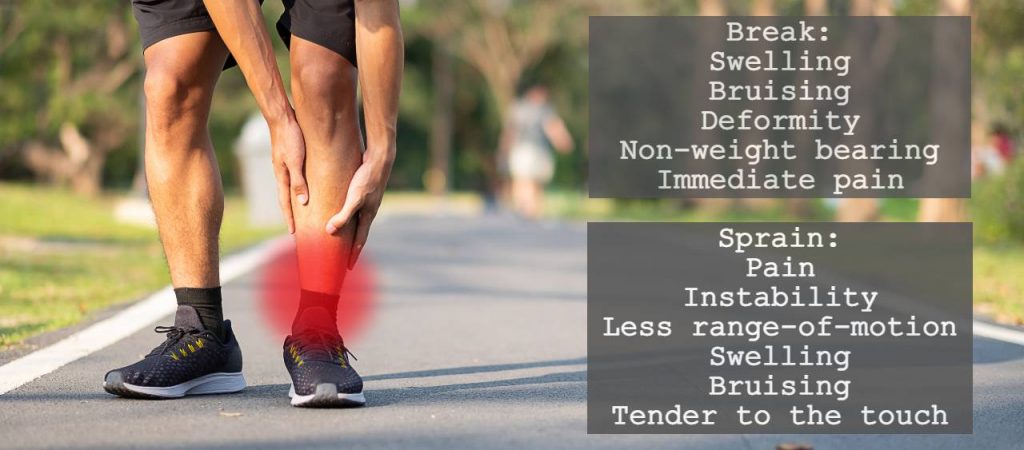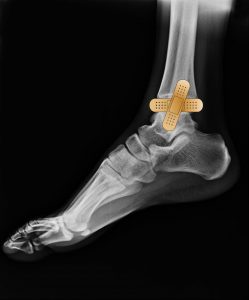
09 Sep An Ankle Sprain vs. a Broken Ankle: Here’s How To Tell Which Injury You Might Have
You didn’t see that uneven sidewalk and tripped or maybe you were hiking a new trail and didn’t see a hole; now your ankle is painful, swollen, and you’re not sure how serious an injury you have. Welcome to end-of-summer injury season! It’s common for people taking advantage of summer’s end to overdo it with activity, or be outside exercising, or enjoying recreation and end up with an accidental injury this time of year. Ankle injuries are definitely not rare!
It can be difficult to assess injury on your own. There are some warning signs of more serious injury to watch out for; however, even if your ankle isn’t broken, a serious sprain can have serious consequences, too.
Although some of the symptoms can overlap, there are some which apply more to either a sprain or a break:
A break can range from less severe to requiring surgical repair, and is typically confirmed on an x-ray.
Sprains also have levels of severity – with grades 1-3. A sprain can be determined by an exam with your physical therapist.
Grade 1: sore and swollen, ligament is overstretched
Grade 2: prolonged pain, swelling, and potential problem bearing weight or bruising. Ligament is partially torn.
Grade 3: severe pain, bruising, and swelling. Unstable and non weight bearing. Ligament is fully torn.
Most ankle injuries occur from rolling the foot outward, although rolling the foot inward can also occur less frequently. A sprain occurs when the ligaments of the ankle are stretched – or when stretched too far, are torn. Some of the same accidental conditions that can cause an ankle sprain can also cause a break, such as slipping (especially in winter months), tripping, and falling. Awkward movements in sports can also cause ankle injury. Depending on your symptoms, it may be possible to try at-home treatment such as rest, ice, and wrapping it.
If your symptoms are more serious, or if they persist, it’s important to visit a professional. A physical therapist can assess your symptoms and injury and may also recommend other testing, such as imaging, if needed. For an injury such as a sprain, seeing a physical therapist is ideal. Your physical therapist will perform a detailed assessment of your injury and history, discuss your goals and educate you on your condition. They’ll also develop a custom treatment plan that will likely include both manual (hands on) therapy and at-home exercises.
While many people assume that a broken ankle is more serious than a sprain (and it is a serious injury!), a sprain can be serious for different reasons. With a sprain comes instability, and a greater risk of future sprain and injury. Many people end up with frequent sprains on the same ankle because the ankle loses stability and is more prone to overstretching. Frequent sprains can result in an unstable joint and issues such as loose bodies in the joint (caused by injury to the joint during a sprain) and even arthritis. That’s why even one sprain should be taken seriously and visiting a physical therapist can help prevent major problems down the road. Not only will you work toward healing your current sprain injury, but you’ll also learn how to strengthen your ankle and help prevent future injury and issues.
If you’re one of the many folks who have a “good” ankle and a “bad” ankle from old injury or multiple sprains – or if you’re stuck on the couch with an ice pack and a new injury, Body One Physical Therapy is here to help get you moving again. Our team of expert PTs works with patients of all ages and activity levels and treat everything from sprained ankles to post-op shoulders, to return-to-sport, and beyond. We’ll make sure you learn what likely contributed to your injury, what your injury is, our plan to help get you better again, and how to help prevent future problems. We’ll work together to reach your goals and measure your progress along the way.
If you’re tired of pain and issues with your ankle, knee, arm, fill-in-the-blank, then it’s time to call Body One, or click here. We have three convenient locations serving Central Indiana: North Meridian, Fishers, and Zionsville. We are locally owned and operated and proud to be a part of the communities we serve. Don’t settle for less than your best: be your best with Body One!
Resources:
https://www.mayoclinic.org/diseases-conditions/broken-ankle/symptoms-causes/syc-20450025
https://www.webmd.com/fitness-exercise/what-is-an-ankle-sprain#2-6














